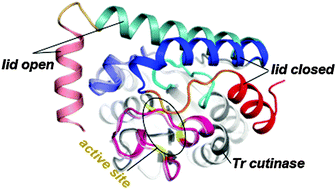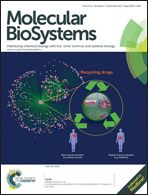pH effects on the structural dynamics of cutinase from Trichoderma reesei: insights from molecular dynamics simulations†
Abstract
Cutinases are utilized in a variety of industries for the hydrolysis of a broad range of substrates, such as cutin, polyesters, soluble esters, insoluble short- and long-chain triglycerides. The novel cutinase from Trichoderma reesei (Tr) attracted much attention due to its two rare characteristics distinct from the classical cutinases: it possesses a lid covering its active site and its optimal activity at acidic pH. However, the structural basis for pH preference and the function of lid is still not well understood. In this work, total of six initial systems were set up either under acidic or basic pH conditions (closed-apo, open-apo and open-holo). Then, molecular dynamics (MD) simulations were performed to make a better understanding of structural dynamics of Tr cutinase under different pH conditions for the first time. The results mainly suggest that it is easier to open for the lid under an acidic pH condition. In addition, the binding of long-chain triglyceride is more stable at lower pH than higher pH. These findings elucidate that how pH influences Tr cutinase at the atomistic level. The structural and dynamic details would be useful for rational enzyme design for acidic cutinase.


 Please wait while we load your content...
Please wait while we load your content...